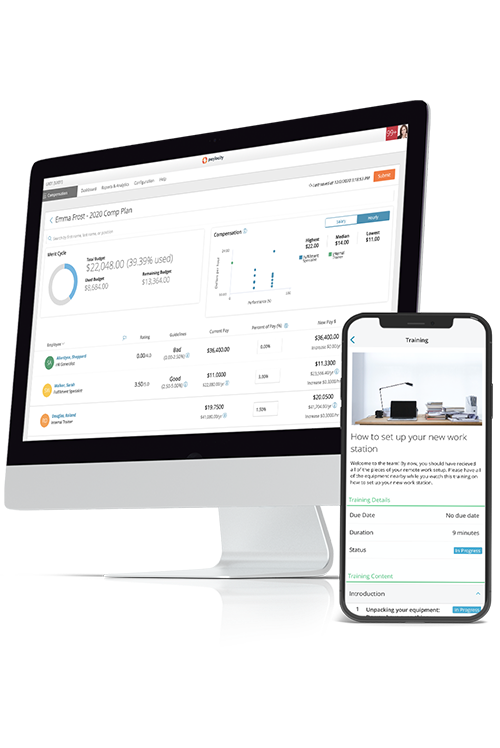resources
What is a Talent Pool? Guide to How to Build & Maintain a Candidate Pool
June 16, 2023
Recruiting can be a hassle — costly, time-consuming, and stressful. Wouldn't it be awesome if you had a bunch of great candidates already wading in your talent pool?
Blog Post

Skip to end of table of contents
Table of Contents
Navigating a competitive job market, like battling a rip current, can leave you constantly swimming for shore. That’s where having an agile talent pool helps.
As soon as you fill one crucial position, someone else leaves. Ever wished for a reservoir of pre-screened candidates ready to dive in at short notice? If your recruitment pool is more of a kiddie pool, don’t worry. We're here to guide you through top strategies to transform it into a reservoir!
In this article, we’ll explore talent pools, uncovering what they’re all about. Learn how your organization can battle a high turnover rate by creating and sustaining a reliable stream of labor.
Key Takeaways
- A talent pool is a database of potential qualified job candidates sourced from a variety of sources, including previous applicants, former employees, internal prospects, and more.
- These databases are populated with detailed information about prospective candidates and their qualifications, and act as a short-list for filling talent gaps when the need arises.
- The best talent pool strategies involve continuously engaging with candidates to maintain interest in employment, even if there isn’t an active role available.
What is a Talent Pool?
A talent pool is a database where employers and human resources professionals keep their best and brightest job candidates. They tend to consist of previous (high-scoring) applicants, former employees, and people referred to your company — basically, anyone you already know is qualified and would likely fit right in with your operation.
A talent pool operates by continuously sourcing, engaging, and nurturing potential candidates. Think of it as the fast lane for any job openings you advertise. It’s full of strong swimmers you know would be a great hire.
So, when the time comes, you already have a carefully cultivated shortlist of pre-vetted candidates. The difference this can make to your recruitment efforts, both in time and effort, shouldn't be underestimated.
What Types of Candidates Fill a Talent Pool?
As you build a talent pool, you might include the following types of candidates:
- Freelancers and Contractors: Individuals who offer their services on a freelance or contract basis, providing specialized skills for specific projects.
- Previous Applicants and Candidates: Individuals who have previously applied for positions within the organization, demonstrating an initial interest in the company.
- Internal Talent: Employees within the organization who possess diverse skills and talents that can be leveraged for different roles or projects.
- University or College Interns: Students or recent graduates who have completed internships with the organization and are familiar with its culture and operations.
- Industry Events and Networking Contacts: Professionals met at industry events or through networking who have expressed interest in collaborating or working with the organization.
Talent Pool vs. Talent Pipeline
A talent pool and a talent pipeline, while related, aren't the same.
Your talent pool is a broader set of candidates who have expressed interest in working for your organization but aren't in active recruitment.
Conversely, your talent pipeline is a smaller list of candidates currently being considered for a role at your organization.
You can think of your talent pool as a source of candidates for your talent pipeline. And if someone in your talent pipeline isn't hired for a particular role, they can flow back into your talent pool and be considered for future openings.
What Are the Benefits of Talent Pools?
Let’s be honest. Recruiting for some positions can feel like finding a needle in a haystack. So, how do talent pools alleviate some recruiting pressures?
More Efficient Recruiting
Talent pools act as a magnet, streamlining the search for qualified candidates and reducing the time to hire.
By maintaining a ready pool of talent, you not only save time and resources but also minimize the cost per hire, eliminating the need to sift through piles of unsuitable applicants.
High-Quality Candidates
Moreover, talent pools allow recruiters to engage proactively with quality candidates. By nurturing relationships with these prospects over time, organizations can build a strong talent pipeline for each new position and maintain a competitive edge.
Fewer Recruiting Gaps
Finally, talent pools foster long-term, strategic workforce planning, enabling companies to efficiently anticipate and fulfill future talent needs.
Ultimately, talent pools serve as a valuable part of any talent management system by attracting, engaging, and securing top talent for organizations.
Before You Start: Building Your Talent Pool Strategy
Planning how you’ll fill and maintain your talent pool before you start is key to success.
As you begin to build out your strategy, consider the following:
Role and Qualification Requirements
The purpose of a talent pool is to make identifying qualified candidates easier and faster. So, before you start filling your pool with every fish in the sea, make sure you establish candidate criteria.
Ask yourself:
- Which roles need to be accounted for within the talent pool?
- What are the key skills, qualifications, and certifications required for these roles?
- Where are there current gaps in my workforce’s skill sets that may need filling?
- When should I anticipate labor needs or shortages?
Pro Tip: Leverage Workforce Forecasting to Anticipate Labor Needs
Workforce forecasting is the process of using quantitative data and qualitative data to predict future staffing needs. Synthesize this analytical approach with your other candidate requirements to build a more data-driven and strategic talent pool.
For more information, check out our article Workforce Forecasting: Your Staffing Super Power.
Workforce Makeup and Diversity
If you continue to recruit as you always have, you may widen any diversity or representation gaps already present in your organization. Prioritize diversity and inclusion from the outset to enhance innovation, decision-making, and representation.
To account for this, consider:
- What is my current workforce makeup?
- Do I need to address a lack of diversity or representation?
- Are these gaps present in specific teams, locations, or roles?
- How can I intentionally source and engage with more diverse talent?
Maintaining Engagement
A key component of a talent pool strategy is engaging with potential candidates to keep them “warm.” You can add thousands of names to a database, but if you don’t proactively reach out, your “talent pool” is nothing more than a cold-calling list.
To define your engagement strategies, ask yourself:
- What techniques will I use to engage with my talent pool (for example, social media posts, networking events, or content creation)?
- What’s the cadence for executing these strategies?
- Do I have the resources and technology to effectively engage with potential candidates?
How to Build a Talent Pool in 6 Easy Steps
So, we know talent pools are essential tools in modern-day recruiting. But where do you find the right people to build a talent pool for yourself?
1. Look to Previous Applicants
When developing talent pools, pay attention to previous applicants who impressed you in previous interviews but weren’t ultimately hired. They might be the perfect fit for a future vacancy, and it’ll pay off to keep track of them.
These individuals have already expressed interest in your organization and may have gained additional skills or experience since their last application.
Contacting past silver medalists could result in successful hires, and it helps maintain positive relationships with those interested in your company.
2. Keep Up with Former Employees
It’s always sad to watch talented people leave for greener pastures, so why not try and reconnect when the timing is right?
It’s crucial to maintain relationships with any former employees who left the door open for a possible return. They already know your culture and how everything works, which would make reintegration a breeze.
3. Foster Internal Candidates
Sometimes, the best candidates are already a part of your company, and internal recruitment is the key. If you have an employee you think could prosper in a more senior role or would be well suited to another opening, it’s worth including them in any shortlists.
This approach promotes employee development and a sense of loyalty and motivation among your workforce. Few things are better appreciated than knowing your skills and aspirations are recognized and valued. This can be an effective retention strategy as well!
4. Diversify Your Recruitment Channels
Actively sourcing candidates from various backgrounds is crucial when looking at how to build a diverse talent pool. Embracing diversity, equity, inclusion, and accessibility (DEIA) principles and sources broadens perspectives, drives innovation, and enhances organizational performance.
Inclusive hiring brings diverse perspectives and backgrounds to the workplace, which enriches an organization's culture and improves its adaptability.
5. Go Global
Having a global talent pool to draw from has become increasingly important in recent years. By leveraging remote work opportunities and digital platforms, organizations can cast a wider net to attract talent from around the globe.
Like DEIA, hiring remote employees enables access to a diverse range of skills, expertise, and cultural insights, fostering a dynamic and inclusive work environment.
6. Ask Your Current Employees
Employees can also help build your talent pool by referring qualified candidates from their personal and professional networks. After all, what’s better than a personal recommendation?
Referrals have a higher success rate regarding cultural fit and job performance, as they come with endorsements from trusted sources — your staff!
Implementing a structured referral program incentivizes employees to actively participate in the talent acquisition process, thereby expanding the reach and quality of the talent pool.
How to Manage Your Talent Pool: Top Tactics
Talent pools are like bonsai trees. You’ve got to pay close attention and give them all the care they need to flourish. Ignore or neglect them, and the beautiful creation you started with will wither away.
So, how can you perfect talent pool management to ensure this doesn’t happen?
Build and Nurture Relationships
Fostering relationships with potential new hires in your talent pool is crucial for long-term success. After all, if they’re successful, you’ll spend a lot of time with them! By actively engaging with candidates, you can establish rapport, trust, and a sense of connection.
You can do this with personalized messaging, targeted content, and networking events to stay in touch and keep candidates informed about relevant updates or career opportunities.
Investing your time and effort into these relationships allows you to cultivate a talent pool that’s engaged, interested, and open to future opportunities.
Continuously Assess Talent
You probably defined skill requirements at the outset, but those needs can shift. Your workforce may have developed a skills gap, or filled a gap that was previously there.
To keep your talent pool relevant, regularly conduct skills gap analyses within your talent pool and workforce to ensure you’re equipped with high-potential candidates who can fill evolving needs.
Cultivate a habit of assessing individuals to maintain an agile and well-aligned pool that stands ready to meet future challenges.
Effectively Segment and Target Talent
You can have the best potential talent swimming in your pool, but without any organized structure, it might be difficult to fish them out.
As you populate your talent database, organize and segment your candidates based on criteria that are important to you (e.g., skills, experience, industry, location, etc.)
This serves two purposes.
One, it makes it easier to identify relevant candidates when the need arises. You can easily filter your list for the parameters that fit the role you’re seeking to fill.
Two, it makes it easier to tailor your nurture strategy. You can use segments to develop personalized communication, offer relevant opportunities for growth, and create a stronger connection with candidates.
Leverage Technology
Sure, you can store all this critical information in a spreadsheet on your desktop, but that approach is manual, tedious, and error-prone.
To truly build and maintain a winning talent pool, invest in recruiting software. Look for a solution that makes it easy to add leads to a database, store resumes, track candidate interactions, and has robust search and segmenting capabilities so you can find your star talent when the time is right.
Building and maintaining your talent pool is an ongoing effort, so it’s important to have the right HR tech at your side to alleviate the administrative burden that comes with this important recruiting resource.
Read More: Employee Recruitment Strategies: Hiring the Top Talent
Master Talent Pooling and Attract the Top Candidates With Paylocity’s Talent Management System
Ensuring seamless recruitment processes is a top priority for HR professionals. By nurturing a talent pool, you'll find it much easier to match the right people with the right jobs when inevitable vacancies arise.
Explore Paylocity's comprehensive HR tools, featuring:
- A user-friendly recruiting platform designed to simplify your hiring process for you and your candidates.
- A robust leads database that empowers you to maintain a full pool of qualified candidates.
- Integrated communication capabilities to make reaching out to candidates a breeze.
Request a demo today to discover how Paylocity's HR and Payroll talent pool software can help you fill your recruitment pool to the brim.

The Tools You Need to Attract and Retain
Embed employee experience features from recruiting, onboarding, and beyond with tools built for the modern workforce. Kick off day one with a welcome message using video. Connect your employees with collaboration tools and peer groups. Develop your team with relevant and interesting training. Keep the conversation going with surveys. And do it all while automating and collecting data to proactively make improvements.


